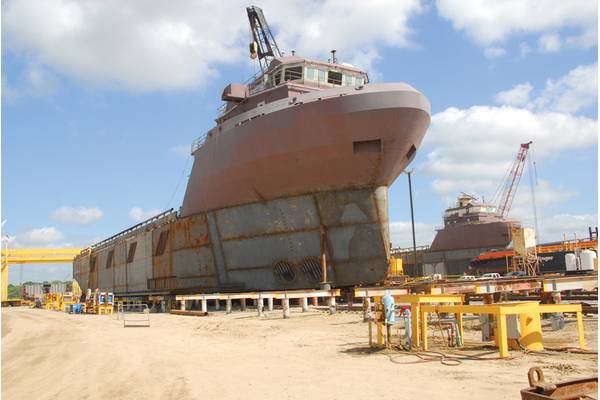
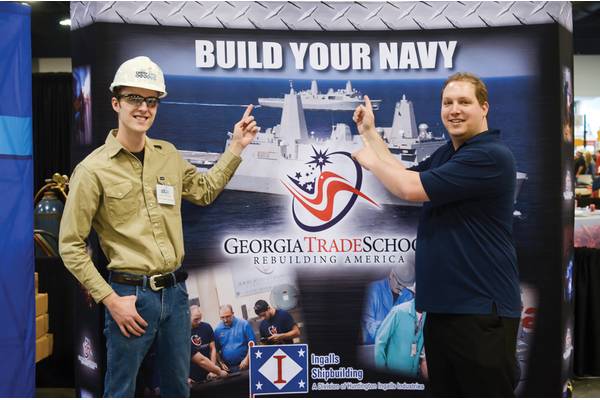

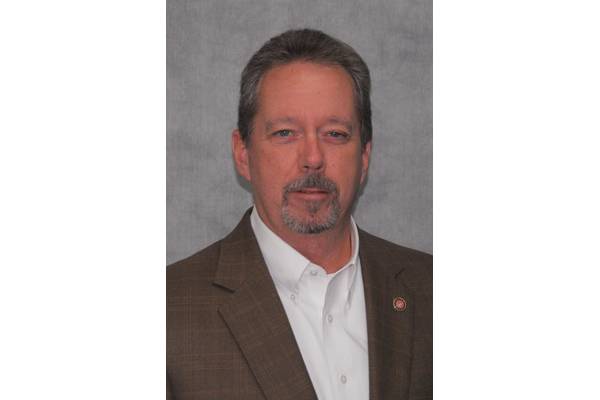
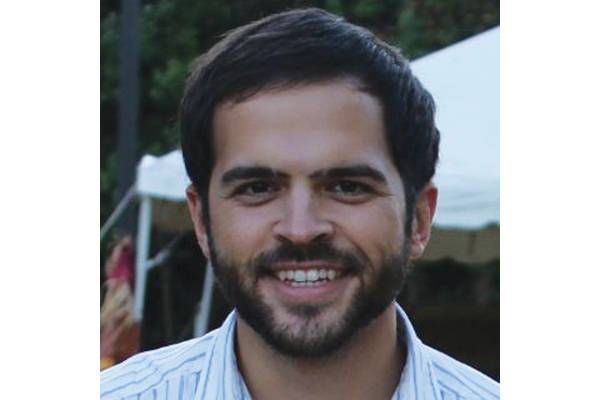

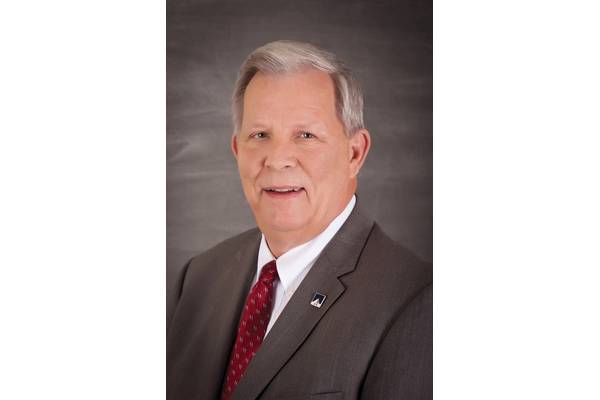
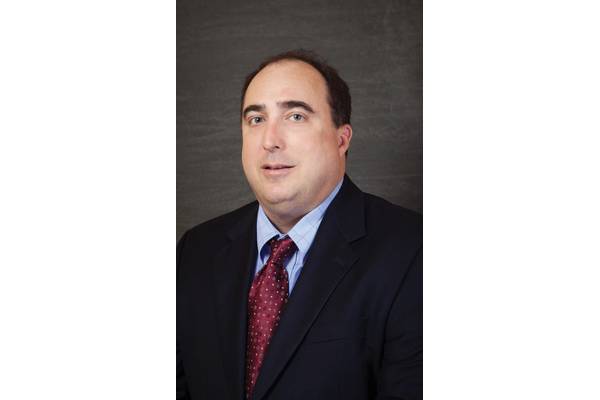

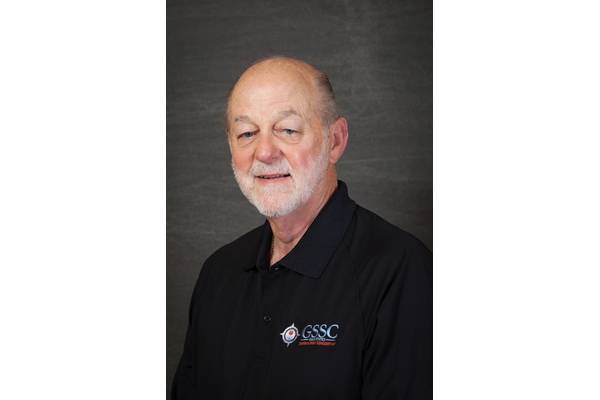
The domestic shipyard industry is traditionally a cyclical business that sees wild upswings followed by deep downturns. More than 30 deep draft vessels reside on the back order books, supplemented by offshore energy fleet replacements and an inland industry that is rapidly modernizing, making this particular boom cycle especially pronounced. Moreover, and with subchapter M and the Ballast Water rules lurking just around the corner, the prospects for sustaining these conditions are very good. If – that is – we can find the right people, trained correctly, to do the job.
How each shipyard will attract the talent to perform this work, retain that talent and train it properly, are therefore important issues to the industry today. That’s what this edition’s industry roundtable tackles in the pages to come. Listen in as human resources personnel and educators from Shipyards, Training Providers and Industry Consortiums weigh in on the challenges ahead for recruiters, trainers and the prospective shipyard employees themselves.
What is the biggest issue facing HR managers at shipyards today? Is it recruitment, training, retention – or all three?
Ryan Blythe, Executive Director, Georgia Trade School: I work in welding education but many of my graduates work in shipbuilding. The biggest challenge is that my students come primarily from the Atlanta Metropolitan area and they have to make a significant cultural change to work in the smaller towns that surround shipyards. Some make the adjustment more successfully than others. The primary reason we see welders returning to Georgia is not their view of the employer or their welding skills not being at a suitable level but instead their inability to find a strong work/life balance. We train by design a very young group (18 to 22 is our primary demo) and they place a premium on work life balance.
Ray Barker, Human Resources Director, Bollinger Shipyards: The biggest issue today is the critical lack of skilled metal craft workers. This is being driven by many factors including an aging workforce, workers leaving the industry for new occupations and an ever dwindling pool of new workers. Young men and women are not entering the skilled crafts at the same rates as they have in past decades. This skilled craft gap affects all areas.
Ryan Lee, Workforce Development Manager Austal: All three. Really they are part of one system. Our issues with recruitment, training and retention are symptomatic of a deeper issue with a shrinking skilled workforce.
Barb Plastic, Director of Human Resources / Gulf Marine Ship Repair: We experience issues with all three. Finding qualified candidates for our highly skilled positions is very difficult.
Byron Dunn, Alabama Technology Network Regional Director, Gulf States Shipbuilders Consortium President, and National Maritime Education Council Treasurer: The biggest issue is training. If there were enough trained and capable folks in the workforce, recruiting would become a very easy issue. Recruiting is important to the shipyards today because there are not enough readily available craft workers in the market. Recruiting is an issue for the educational and training organizations. How do we interest the new young workers looking to enter the workplace in a job in the shipbuilding and repair industry, or any industry where craft workers are needed? On the subject of retention, over the next decade and a half, we will need to look at retention numbers a little differently. We all know that the boomers are going to be retiring in droves. This will mean there has to be turnover in the workforce. There will very little a company can do or offer to retain those older workers. They will retire. So every industry will see a churn and turnover in the workforce.
Jeff Allman, Strategic Planner, Huntington Ingalls Shipyard: Recruitment, Training, and Retention present unique challenges for shipyards today; however Recruitment tends to present the most challenging issues for shipyards. Manufacturing jobs in general fight a perception issue of not being highly desirable jobs when in fact these are rewarding career positions that offer employees competitive wages and benefits that allow the person to live above the national standard while also providing wide latitude of career tracts to choose from. Recruitment is challenging in that today’s youth aren’t being steered toward or encouraged to seek Manufacturing Jobs. Parents, School Systems, Guidance Counselors, Government Funding all steer students towards a college degree program. Students/Youth are built up to believe that the only way to be successful in life is to get a college degree. I do not knock a college degree program and an individual can certainly be successful following that tract; however, the facts are that the market place is flooded with degreed candidates that are competing for limited numbers of opportunities. Manufacturing Jobs on the other hand tend to be viewed as a less desirable career tract by those same influences listed above; when in fact, Manufacturing jobs provide tremendous opportunity to learn and develop a skillset that will be the foundation for a rewarding and beneficial career. In the past, Ingalls Shipbuilding would have been able to find qualified candidates available for work within a 150 mile radius of the Pascagoula facility and the recruiting effort would have been minimal and qualified would apply. Today, qualified, experienced, available craftsman do not exist. Ingalls Shipbuilding recruits nationwide for experienced and technically schooled candidates to fill as many openings as possible. Ingalls also recruits unskilled candidates for training positions designed specifically to develop a skill such as Shipfitting. An example of the recruiting efforts Ingalls makes and the challenges presented: In order to hire 80 Shipfitters Ingalls Shipbuilding reviewed 3,200 applications, tested 380 candidates, made job offers to 250, had 200 show up for first day of training, and had 120 fail or quit during the 4 week training program.
In the past 12 months, has your hiring and recruitment situation eased, stayed the same, or become more urgent?
Barb Plastic: During the last six months our hiring has been very active. We hired over 100 skilled craft positions.
Susan Inagaki, Human Resources Director / Gulf Copper & Manufacturing Corp.: It has become more urgent for the most part. However, due to project needs and the topsy-turvy needs within the marine industry we are on an eased recruitment at this time.
Jim Youker, Director, Human Resources / Detyens Shipyards, Inc.: The situation has remained the same. We continue to hire and have been for years, always looking for skilled labor.
Jeff Allman: Recruitment over the last 12 months has continued at an urgent pace. The skill mix that we are currently recruiting for has changed. At the beginning of the year we were recruiting heavily for Structural Welders and Shipfitters; that recruiting effort has eased somewhat, now Ingalls is heavily recruiting for Marine Electricians.
Ryan Lee: The situation has become more urgent as our needs have remained consistent and the market has tightened significantly.
When talking to current or prospective employees, what are the top three things that are important to them when deciding where to apply for work?
Ryan Blythe: They want to feel like they are part of a great team, they want to feel like their work matters, that they are part of an organization that values them and that the end product they weld makes a difference in our country’s infrastructure, economy and national security. One of the mistakes too many employers make is using the “candy” alone to attract top talent. Instead of focusing so much energy into traditional employer benefits, management needs to build a culture that is so powerful their employees will not leave for another yard that offers slightly higher pay.
Susan Inagaki: Pay rate, Overtime available or not, Duration of project/work, employee satisfaction and benefits.
Rhonda George, Personnel Hiring Manager, Signal International: Amount of Pay, Hours (amount of OT they can expect), Length of job.
Ryan Lee: They are typically looking for opportunity/development, the best pay rate, and benefits such as medical, paid time off, etc.
Jeff Allman: Competitive Wages, Work Stability, Benefits.
A goal of the shipyard industry has been to not only standardize shipyard education, but also to create a credentialing system that would assure employers of what they are getting. How is that effort progressing?
Susan Inagaki: I believe that this effort is progressing elsewhere, but not locally to date. I believe that there are current discussion with the local institutions in regards to same and look forward to utilization of same and/or development of an in-house program.
Ryan Lee: It is progressing slowly. I think GSSC, NMEC and NCCER have done a good job; especially considering GSSC does not have paid staff, but the real challenge is getting all the shipyards on the same page. I think most, if not all, the shipyards have key personnel who are buying in, but that has not been enough to influence change at the pace needed. In addition, there are still some unanswered questions as to what this will really look like once it is fully implemented. I don’t think the shipyards really understand what role they need to take on to push this through.
Ryan Blythe: We are one of the few schools that do not participate in NCCER. We have chosen to use our own curriculum based on the experiences that our staff have and what employers in a range of industries from Shipbuilding to Manufacturing have asked for. Our goal is not to simply train a welder to pass a certification exam but to ensure that their skills can be repeated in a variety of environments.
Rhonda George: It has been a steady process. However, we need more participation from companies in supplying SME’s.
Ray Barker: The outlook for the standardized maritime curriculums developed by the NMEC is positive. Louisiana’s Economic Development department and State workforce groups are actively supporting NMEC courses. Several Technical Colleges and Technical High Schools in our area are either actively incorporating NMEC curriculums into their course offerings, or are planning the implementation of these courses. The development and expansion of the NMEC courses are viewed as being critical to the development of a future workforce for our industry.
Byron Dunn: I am proud to say that we feel like we set the bar for short term technical training programs. Before GSSC developed the shipfitter curriculum and held our first three boot camps, I had never heard of a training program had a 100% employment of the those that completed the program. I think that is the new benchmark. Before we started we were told that there was no way we could take someone who had no experience in the industry and in 12 weeks deliver a person who could pass an entry level test. Well, we did it and we did it for 100% of the participants. The model we created shows that never again should we settle for less than 100% success in training programs. Not only should we expect it, we should demand it.
Where does your company accomplish the most training: in-house, contract off-site or on the job? Why?
Barb Plastic: Most of our training is in-house. We have an onsite training facility.
James Ivy, Gulf Coast Shipyard Group: Apprentices are trained off site at the local community college, and also receive on the job training. All others requiring training are trained on the job.
Susan Inagaki: This would be a combination of all types listed. We do expect a certain level of certification for some positions and lean mostly on the in-house/on-the-job training process.
Jim Youker: We utilize all three methods. On the Job Training would be the most common, because it involves more hours per week.
Jeff Allman: Most training is conducting in-house due to the certifications and requirements of the contracts on which we perform. However, Ingalls Shipbuilding has a hiring program in-place for Shipfitter and Structural Welder positions where non-skilled applicants are offered training positions at Mississippi Gulf Coast Community College or at Bishop State Community College in Mobile, Alabama. Applicants that complete these training programs (4-12 weeks) are guaranteed an employment offer with Ingalls Shipbuilding. Once the applicant completes the pre-employment training, The applicant is employed and training requirements are completed at Ingalls training school. This pre-employment program has been highly successful, producing high quality candidates that are motivated to succeed.
Ryan Lee: Most of our training is accomplished pre-hire with Alabama Industrial Development Training (AIDT). Although there are some technical schools/high schools beginning to partner with us, Austal trains our production employees in-house at the AIDT Maritime Training Center (a state-of-the-art training facility provided to Austal and other local Gulf Coast shipyards by the State of Alabama) in apprentice or post-hire training, or what we call On-the-job training (OJT). Overall, I think our in-house and OJT make up our largest portion of training. Pre-hire sees a huge initial volume, but there is a lot of fall out before employment offers are actually made. In the past, pre-hire training through AIDT was our largest volume, but we have had to expand training and sourcing streams just to keep up with demand. As we rely on “entry” level talent more due to the lack of experienced shipbuilders in the market, we have had to expand training and recruitment opportunities to appeal to a wider variety of folks with “transferable” skills and to mitigate the impact of hiring larger volumes of less experienced workers. Essentially the market has gotten so competitive that the competition is shifting from recruiting the best A Class to recruiting the most capable/high potential trainee.
In terms of your workforce, would you characterize it as mature (or long term) and do you anticipate significant attrition due to retirement in the coming five to ten years?
Ryan Lee: Our workforce is young. Our average age is under 40 years old and most of our employees have 3 years of service or less. One of the advantages of building a workforce from the ground up is retirement doesn’t usually have an effect for a while. There are, however, other challenges we contend with, namely generational risk. The younger generations have different aspirations and expectations. Most don’t see themselves staying at a company or in specific job long-term. Statistics tell us most of them will have multiple careers. So, there are challenges either way with regards to retention.
Rhonda George: Mature, yes we expect significant attrition due to the aging crafts workforce.
Jeff Allman: 31% of Ingalls Craft Workforce is age 50 or more and will be eligible for retirement in the next ten years. Ingalls has a number of projects on-going to capture the knowledge of these employees; however this is a significant concern as we work to build and maintain our workforce and capabilities.
Ray Barker: I would characterize our workforce as a mixture of mature employees and those in the beginning of their careers. We do anticipate issues in the next 10 years as our long term employees consider retirement options. Much effort is being focused on developing a future workforce to address attrition rates.
Ryan Blythe: I can answer this from a unique perspective because I serve on the “Go Build Georgia Advisory Council” and tour our state’s employers and technical colleges. Universally, from shipyards to construction, manufacturing and energy tell us that the next decade will be incredibly challenging. With the economy improving we are seeing more cranes than ever and businesses expanding or spending capital they had been withholding. The question is will the labor force be strong enough to meet customer needs. If manufacturers cannot produce their products fast enough as a result of workforce problems we are in real trouble. The rail car industry for example has been going bonkers in our state and around the nation as energy developments have lead to a significant increase in the demand for new cars. We hear the wait for cars can be up to two years!! Another factor is insourcing as more manufacturing will be done as Asia’s middle class develops and it becomes cost prohibitive to send plants overseas. The question is again will we have the ready workforce to support this change.
Susan Inagaki: I would characterize our workforce as mature and feel that there will be a very large “crunch” for craft workers within the next five to ten years. This is largely due to the “push” for our young adults to obtain college degrees along with the lack of momentum toward or lack of the knowledge of the existence of skilled labor careers.
Just one year ago, private shipyards in the United States supported 402,000 jobs and 36 Billion in GDP. At the time, shipyards were facing severe skilled worker shortages. What’s the outlook now?
Barb Plastic: The outlook is still very concerning.
Byron Dunn: As you well know, the shipbuilding and repair industry is very strongly influenced by the economy, interest rates and even events like oil spills. Each yard bases staffing on contracts or orders in hand. Lately, as a whole the yards have been getting more work. Therefore employment along the coast is increasing.
Susan Inagaki: I believe that the issue remains and that a collaborative effort to develop this particular workforce is the key to a successful turnaround.
James Ivy: Our situation remains about the same. There seems to be an increase in the education system promoting and offering more skills training programs.
Ryan Blythe: We send more graduates to Ingalls Shipbuilding than any company in Georgia or the United States for that matter. They have been a terrific partner and have invested in recruiting directly from schools. When prospective students tour our school they see banners of ships our graduates built, it is a very powerful impression to make on a young person trying to decide what pathway they want to take.
Rhonda George: We are facing even greater shortages in the near future due to the aging workforce and lack of youth entering the craft fields.
Shipbuilding and repair activities domestically are still red hot. Where is the biggest skill gap at this moment in terms of that business?
Jim Youker: We could use people in ALL trades.
Ryan Lee: In terms of soft skills; attendance, mechanical aptitude, critical thinking, and leadership skills are among the most desired. For craft/technical skills, it’s welding, pipe fitting, structural fitting and a general lack of credentialed/qualified engineers.
Ray Barker: Our experience is that the biggest skill gap is in the piping trades as vessel piping systems become more and more complex.
What’s changed in terms of your missions and industry conditions – if anything – in the short span of 12 months since we last profiled this training initiative?
Byron Dunn: NCCER Maritime Training materials are now available nationally. Introduction to Maritime Industry – a Core elective, Maritime Structural Fitter levels 1 & 2, and Maritime Pipefitting are all available. That’s a big step forward. Before that, the only standardized curriculum was the GSSC Shipfitter Boot Camp curriculum.
Jim Youker: We have begun working with state, college, and local high schools to get young people involved in one single training initiative program that will develop Industrial Mechanics/Engineers.
The advances in training and technology change a lot of businesses over time. Give us some examples of this on the waterfront, especially in shipbuilding.
Byron Dunn: If you take just one craft; welding, think how much more a welder needs to know today compared to 10 years ago. Different gases, different fill material, and more exotic metals to weld. Simulators are much better than even 3 years ago. And, that technology is moving form classroom to production. Never before in history have we been able to objectively measure work angle, travel angle, wire speed, etc. In training it’s a great way for students to learn through objective measurable feedback. Transferring the technology to the job on live welds will help workers to produce a higher quality joint.
Ray Barker: Technology and training advances have changed the industry and how vessels are constructed today. Advances such as 3-D modeling enable engineering personnel to provide a construction puzzle with validated pieces through automated machinery that offers craft workers a map in constructing a vessel. With the inclusion of accuracy/control tools, many measurements are initiated on the ship and offer immediate results to ensure proper alignment/fits. These technological advances have been incorporated within shipbuilding processes and have allowed for today’s craft workers to achieve attainable skill sets easier/quicker than it was in the past 10 years. Because of this, programs such as the GSSC’s ship fitting boot camp and the NMEC’s maritime curriculums are now viable training programs for the industry.
Have more shipyards signed on board with the standardized training models?
Byron Dunn: Mostly it has been the community colleges and other training providers who have signed on to deliver the training or offer boot camps. However, the shipyards eagerly await the newest graduates of the programs. That’s why the employment rate is 100% from the boot camps.
The National Center for Construction Education and Research (NCCER) model can be used for specific task training on site, for remediation, or as part of a larger course of study. NCCER boasts 4,000 points of delivery for training and assessments under 912 individual programs and supports delivery of training in a blended learning environment. Compare today’s NMEC’s metrics to this breadth of delivery.
Byron Dunn: Everything you mentioned above is why GSSC and NMEC decide to partner with NCCER. In essence, NMEC has been the organization that is trying to raise the funds to let NCCER continue to develop maritime curriculum and assessments. So, by partnering with NCCER, the maritime industry can now benefit from the NCCER model including its infrastructure, oversight, development resources, delivery sites and Automated National Registry. When we started down this path in GSSC, we never wanted to reinvent or duplicate the wheel, where one existed. We prefer to find the best wheel and fit it to our wagon. Our goal was to prove that standardized training and credentialing would benefit the industry. While we were it the process of developing the Shipfitter Curriculum, we discovered NCCER. Everything we wanted to do for the industry, they had already done for the construction industry. It just made sense for us to “stand on their shoulders” and bring their top notch program to the shipbuilding and repair industry instead of trying to create something separate for the industry.
(As published in the 4Q 2014 edition of Maritime Professional - www.maritimeprofessional.com)


